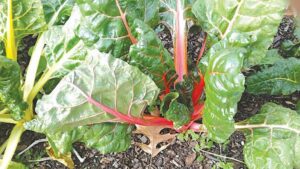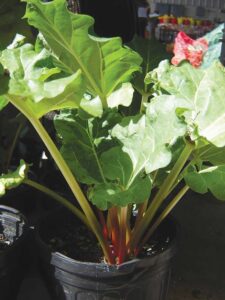At a recent garden tour in Columbia a couple from Illinois asked me, “How do you grow rhubarb in South Carolina?” Rhubarb is a quintessential sign of spring in northern regions of the U.S. with cooler temperatures and long cold winters. Growing up in Illinois in USDA hardiness zone 5, my family grew huge rhubarb plants. My grandmother and mother made delicious strawberry-rhubarb pie, rhubarb pudding, rhubarb crisp, golden rhubarb cream, rhubarb sherbet, and rhubarb ring.
Rhubarb is an herbaceous perennial in the buckwheat family and native to China where the root and rhizome were used as a medicinal to address digestive issues, liver problems, pain, and inflammation.
Rhubarb became a food staple only in recent history. John Bartram and Benjamin Franklin introduced plants and seeds from England to America in the 1700s. The bright red upright stems are the edible part. The leaves have oxalic acid and are poisonous to people, pets, and other animals.
Botanically, rhubarb is a vegetable, although it is used as a fruit. In 1947 the USDA declared it was a fruit not only due to its culinary use but also because tariffs on imported fruits were lower than for vegetables.
Since rhubarb doesn’t thrive in high heat and humidity in zone 8 gardens of South Carolina, it is best to grow rhubarb as a cool-season plant. In fall, site the plant with six hours of morning sun in an eastern exposure, so by the heat of afternoon it will be in shade. Or one could plant the rhizomes in portable pots and move the plant as needed.
Rhubarb needs rich compost or aged manure amended well-drained soil with a slightly acid pH between 5.5 to 6.5. Plant the seeds or rhizomes in fall. Space plants four to six feet apart to allow for ample growth and air circulation. Mature rhubarb plants can reach 2.5-3 feet high and wide. Mulch plants to help retain moisture and retard weeds. It may take two to three years of growth before plants are established and produce a good yield ready to harvest in spring. Apply water at the base of the plant, not overhead. When the plant sends up flower stalks, pull them off at the base before the flowers open. This allows the plant to focus its energy on growing edible stalks and healthy leaves rather than producing seed. Fertilize rhubarb with an organic fertilizer like Espoma Planttone.
Four rhubarb varieties recommended for South Carolina are Victoria, an heirloom variety from the 1800s; KangaRhu™, a heat-tolerant, flavorful, deep red stem variety from Australia, self-pollinating Starkrimson®; and Hardy-Tarty™.
Celebrate National Strawberry-Rhubarb Pie Day on June 9.
Rhubarb Plant
and Seed Sources
www.burpee.com
www.gurneys.com
www.johnnyseeds.com
www.starkbros.com








Loading Comments